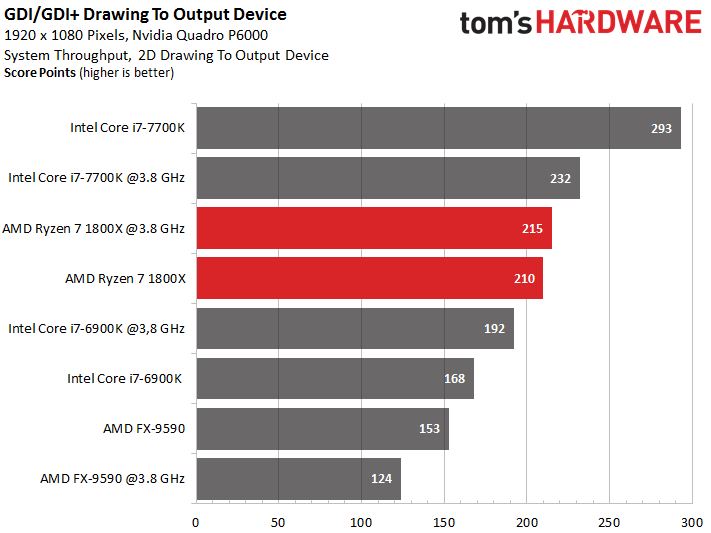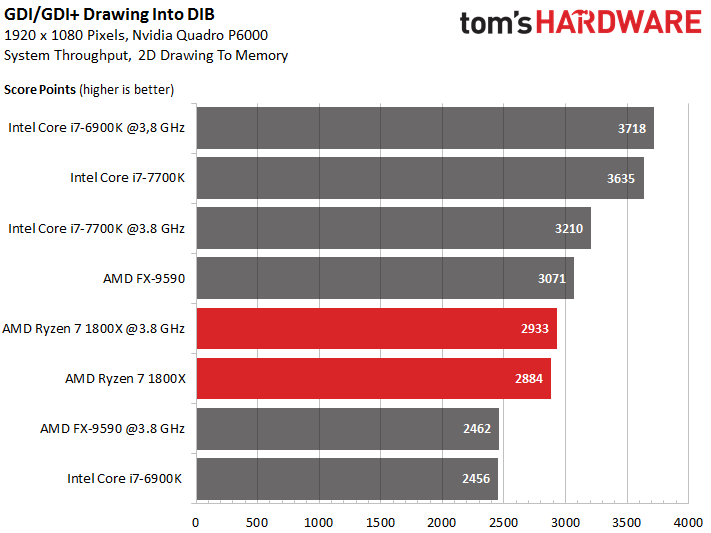AMD Ryzen 7 1800X CPU Review
Why you can trust Tom's Hardware
Results: Desktop & Office
It takes more than 18 hours to run the office, workstation and HPC (High Performance Computing) benchmarks once. Consequently, we limited our tests to a total of four CPUs and two runs each (i.e., at stock clock frequency and at 3.8GHz). We used Microsoft Windows’ performance profile for all of the tests. AMD’s older generation is represented by the 5GH FX-9590, which necessitates water cooling.
We get going with a good old friend: the GDI/GDI+ benchmark. We decided to start with it, because its results will provide context for what’s to come later. This benchmark is used to test two different ways to output 2D objects. These are primarily found in older applications, print output, and, in a modified form, in today’s GUI display. We’re using an Nvidia Quadro P6000, since it represents the best available graphics performance that money can buy. This means that there’s no GPU bottleneck to worry about whatsoever.
We start with directly drawing to an output device. The graphics driver uses the CPU quite heavily for this task, but, for the most part, doesn’t use that many threads. This is due to the demise of true 2D hardware acceleration with the introduction of the unified shader architecture. The Microsoft Windows driver model’s also not exactly conducive to it. It’s interesting to see that, in spite of all of this, AMD’s new Ryzen 7 1800X manages to beat Intel’s Core i7-6900K. Since each individual action has to make its way through the entire system, these results aren’t just representative of processor performance, but also include chipset performance.
Next, we add a memory task by using the single 2D function that’s still hardware-based: copying the graphics output from the place in memory where it was built to the output device. We’re executing the exact same steps, but draw a virtual bitmap and not on the monitor. Only the completed picture is sent to the output device. The result is that the CPU load increases significantly, which, in turn, has a surprisingly large impact on the benchmark results. Without the rest of the system providing a bottleneck, the older FX-9590 manages to beat AMD’s new offerings. Only if its clock frequency is lowered to 3.8GHz does it have to admit defeat. The same goes for Intel’s Core i7-6900K.
Update (this is in reference to some reader questions about these results): Drawing into DIB is a pure 2D workload, and the stock i7-6900K can't reach its highest possible clock rate in this low-priority multi-threaded workload. To be specific, the i7-6900K spreads the workload over its 16 threads, so the processor runs at close-to-idle clock speed, because it only utilizes 20% of many of its cores. The distributed workload also strips the processor of its Turbo Boost capabilities.
By comparison, the -7700K spreads the workload among half the threads, which yields a higher load per core, thus boosting its clock speed. The -6900K at 3.8GHz also experiences a boost because it has 50% more clock speed than its stock configuration.
This test further implies that AMD is able to transition between power states faster than the Intel processors, which means it is tuned well for light workloads.
Get Tom's Hardware's best news and in-depth reviews, straight to your inbox.
These findings are of great significance for AutoCAD, which we get to on the next page. Ultimately, AutoCAD draws all of its output in memory first, and then sends it to the monitor.
DTP & Presentation
Adobe’s Creative Cloud makes for an exemplary benchmark, and it certainly makes more sense to use a real-world application than a synthetic benchmark. It tests both single- and multicore performance.

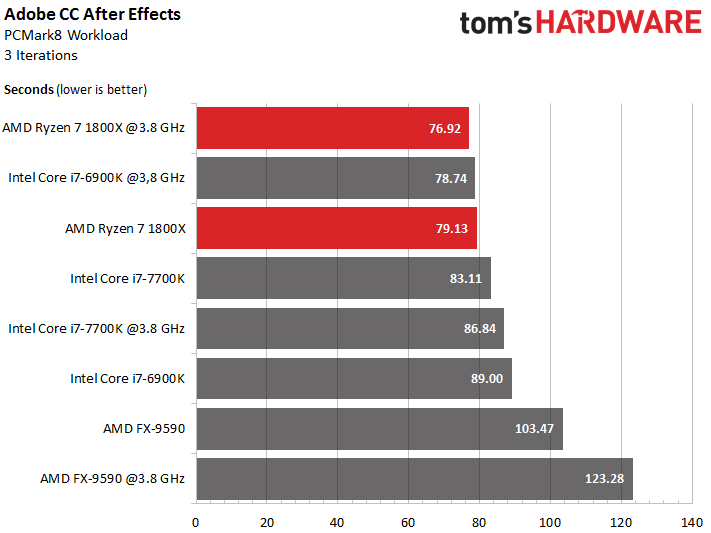
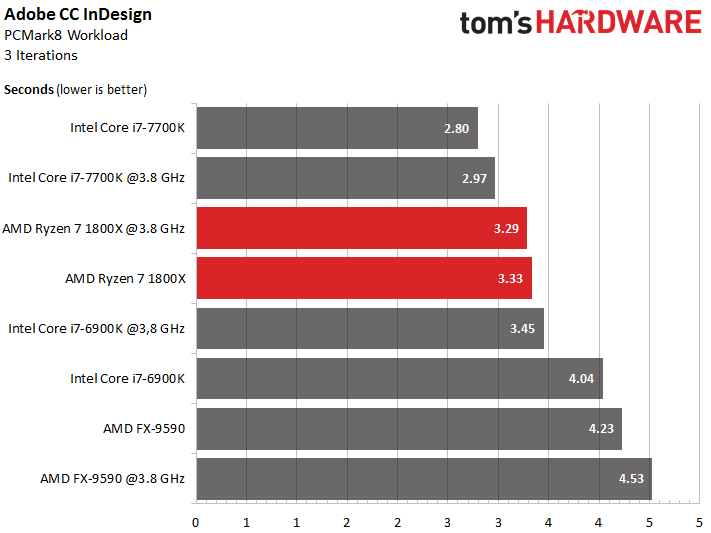
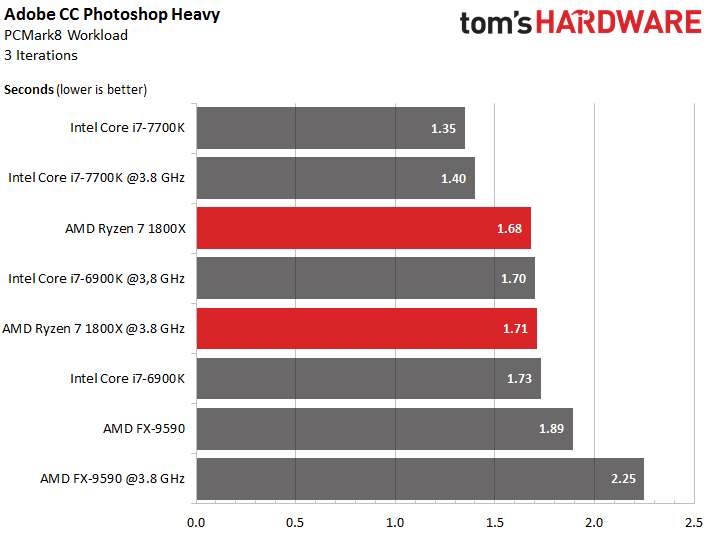

Encoding & Multimedia
AMD’s Ryzen 7 1800X can live up to its full potential with our Handbrake benchmark. No matter what the quality is set to, AMD’s new processor just crunches away.


Compression & Decompression
Crunching lots of numbers in short order is also very useful for file compression. AMD’s Ryzen 7 1800X manages to draw even with Intel’s Core i7-6900K at the same clock frequency. Intel’s Core i7-7700K takes the lead when it comes to decompression due to its higher clock frequency. In the end, packing’s harder than unpacking.


Programming in Python
This application sits right on the boundary to the workstation space, and thus leads us seamlessly to the next page. Apart from the visual task library (e.g., graphically complex charts), which pose problems due to the usual reasons (i.e., difficulties with parallelization), the scientific and engineering fields are where AMD’s Ryzen 7 1800X shines.


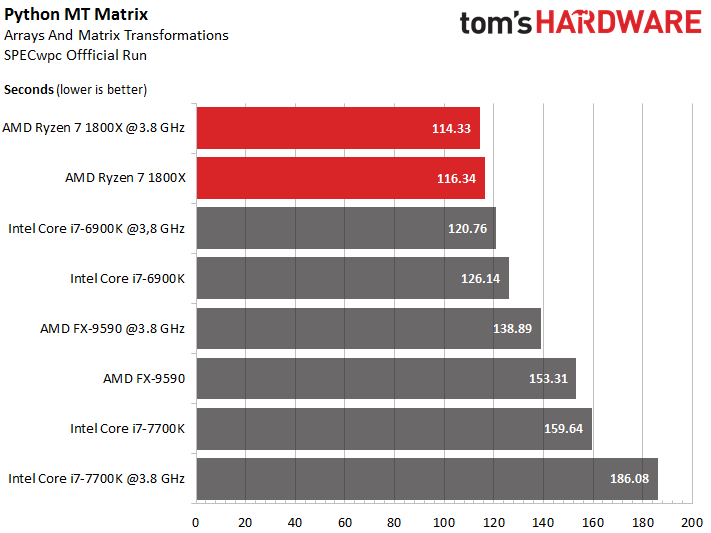
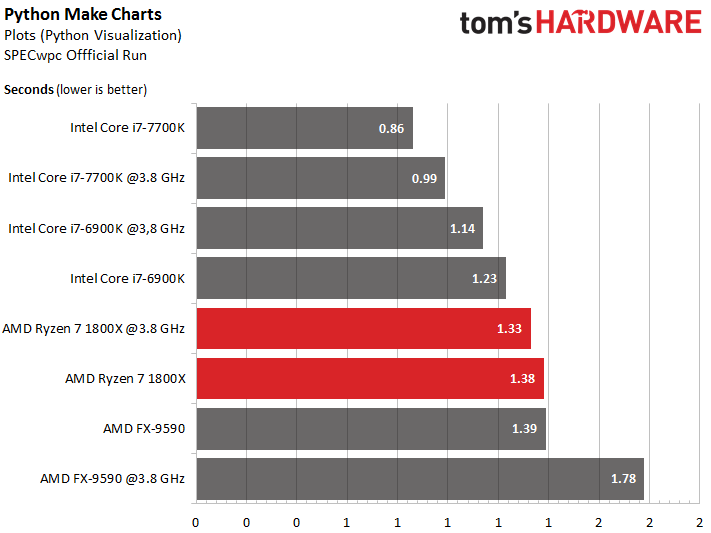
Ryzen’s a well-suited CPU for both developers and users due to the fact that many libraries don’t provide an explicit advantage for Intel processors.
Bottom Line
With Ryzen, AMD has produced a processor that’s competitive in many application areas. It certainly doesn’t have to hide from Intel’s current octa-core offerings. The price/performance ratio makes it an interesting choice for commercial applications, unless the application in question specifically demands an Intel CPU.
Current page: Results: Desktop & Office
Prev Page Hitman, Project CARS & Metro: Last Light Next Page Results: Workstation
Paul Alcorn is the Editor-in-Chief for Tom's Hardware US. He also writes news and reviews on CPUs, storage, and enterprise hardware.
-
vrumor Well, at the very least, it is competition. Competition drives innovation and lower costs. Well done AMD.Reply -
kiniku Why did I feel AMD was hiding something? Understandably the "gamer market" is comparatively small. But couldn't AMD have designed a CPU that worked well in gaming/desktops and in data centers? Disappointing.Reply
(But I have a 5820K. The best Ryzen in the world would not have had me switch anyway.) -
xryanx123 Bias review as always. Most of your information is obviously screwed up. How do you get 4.0ghz at 1.45v. When that's not even an overclock for the chip (not really at least compared to stock) yet you're already pushing 1.45v? You're tailoring your articles for the uneducated. Duck off tomsReply -
captaincharisma in the end the best anyone can hope from AMD is that it spooked intel enough to lower its pricesReply -
ssdpro In a hurry to compare various site's gaming results, it appears differing sites are finding the same thing: gaming performance is acceptable but below 4c/8t Intel offerings. If you spend your day encoding or multi-thread benching this is a monster bargain.Reply
With the good and bad, I think we can all agree the good here is competition. There is some now. -
Pompompaihn All along AMD was claiming to equal/beat Broadwell-E in comparative tasks at half the price, and from another review that included Broadwell-E, it's done that. I don't recall ANY AMD press saying it was going to beat the 7700K in straight up gaming. So, target set, and hit. That's a win in my book. But now, need to see what they can do with the smaller core count chips and if they can scale frequency to be competitive in the gaming sector.Reply -
Dionisiatis Maybe i missed it but i would love to see a perf/dollar ratio comparison. Im sure Ryzen would occupy the top position, and it would also make it clear that AMD achieved extraordinary results in bringing such high performance to the average consumer that cant 700+ dollars for a CPU.Reply -
jackspeed @Dionisiatis the 7700K is cheaper then the 1800X so for gamers it currently is the best CPU. now games have yet to optimize for the new AMD architecture, so maybe soon it will be a different story.Reply -
Aspiring techie Your "Heating up AMD Ryzen" video on the Power and Temperatures tab is still private. I can't watch it.Reply -
Fails in gaming, and for multitasking stuff i got Xeon 14/28 who is doing all that encoding and other stuff for $300 on eBay.Reply
In my opinion AMD failed and they really pulled BS by fooling people into pre ordering but it turns out that in gaming sucks..
